How to Enable a Feedback Culture
Find out our best practices for giving feedback, and how to enable a feedback culture in your organization.
The feedback contradiction
The ability to provide effective performance feedback is a critical skill for managers, supervisors and leaders. When feedback is delivered correctly it helps employees grow and develop, learn new skills and achieve success for both themselves and for the wider organization.
However, whilst performance feedback is the one of the key drivers of organizational growth, it often does not motivate improvement amongst employees. This is because because typical approaches to feedback are based sporadic critiques of employees' past performance. In this webcast, we will show you how to create a feedback culture that will enable positive and useful feedback conversations across your organization.
Watch the full webcast here:
Embedded content: https://www.youtube.com/embed/40Orm61wwBs
Introduction to feedback
Giving feedback on employee performance is one of the key elements of supervision and coaching, it forms an integral part of employee growth and development within an organization. However, good feedback must consist of a mixture of positive and constructive. Giving an employee solely positive recognition will not allow them to reach their full potential, so it is essential to also give constructive feedback.
Recent studies have shown the performance feedback discussions can have a counterproductive effect on employees if they are not carried out correctly. For example, they may lower thier goals or reduce commitment to their role.
Finally, another trend in performance management is the move away from annual performance reviews, to a continuous feedback model, which we will discuss later on.
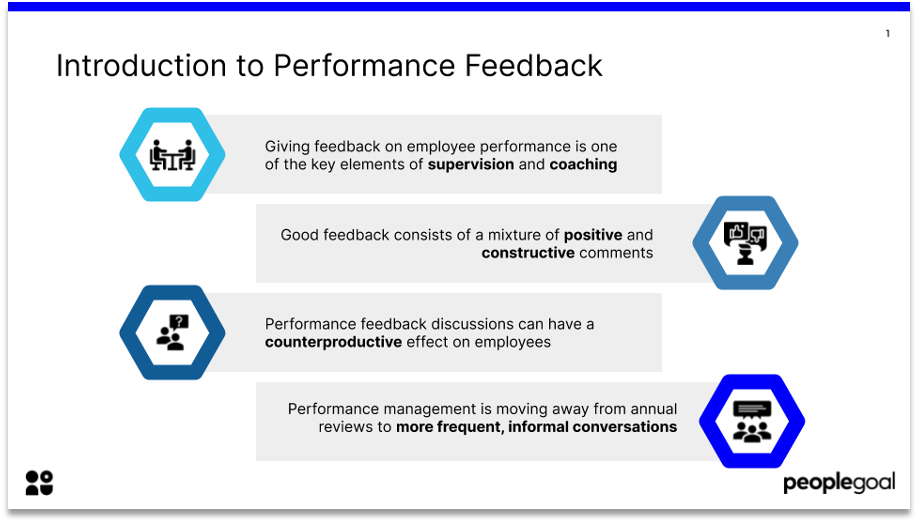
Components of feedback culture
An environment where employees feel comfortable giving and receiving feedback openly, and are actively encouraged to give each other positive and constructive feedback on a regular basis.
1. Continuous
First of all, it is import to shorten the feedback loop so that employees can receive frequent and informal feedback. This will help them to better understand their current performance and make the necessary improvements. Frequent feedback will help employees adapt quickly, and managers will be able to track their improvements based on the feedback given.
2. Immediate
Feedback must be given as soon as possible as it is necessary for employee learning. Be prompt, kind and specific, giving employees the opportunity to reflect before adjusting their behaviour.
3. Transparent
Being transparent with feedback will build trust between the employee, the manager and the organization, which will ultimately boost engagement and lead to higher levels of performance.
4. Organization wide
Feedback should not only be given 'top down' from managers to their direct reports, but also peer to peer and 'bottom up' from employees back to the organization. Employees should be able to give their feedback back to their managers, as well as give peer feedback to their co-workers.
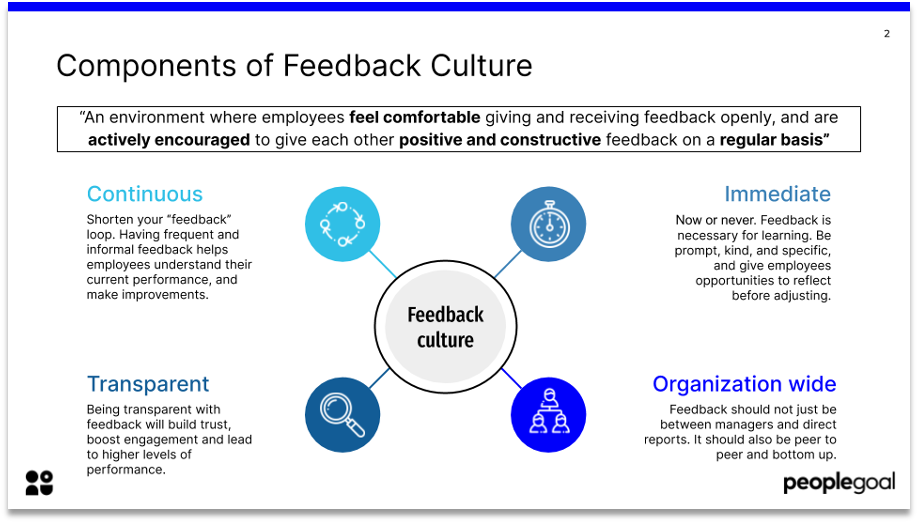
How a feedback culture benefits business?
Organizations need to __share the benefits of having a feedback culture with their employees so they can see what they can get out of the feedback process. Many employees and managers are not open to feedback as they feel like it is purely a critique of their performance, however this is not the case.
Employees
- Accelerate personal and professional growth
- Elevate performance
- Develop new skills
- Higher productivity
Teams
- Improve communication
- Improve working relationships
- Reduce conflict
Organization
- Increase motivation and engagement
- Reduce employee turnover and absenteeism
- Improve leadership effectiveness
- Higher profitability

Different methods of providing feedback
- 1 on 1 check-ins
- Office hour drop-ins
- Group retrospectives
- Speed-back
- 360-degree feedback
- Feedback survyes
It is important to use a wide range of feedback methods. The more feedback methods you can incorporate into your organization, the better. As employees and managers get accustomed to giving feedback regularly in a variety of ways, it will become second nature and they will begin to achieve a growth mindset which is a byproduct of a successful feedback culture.
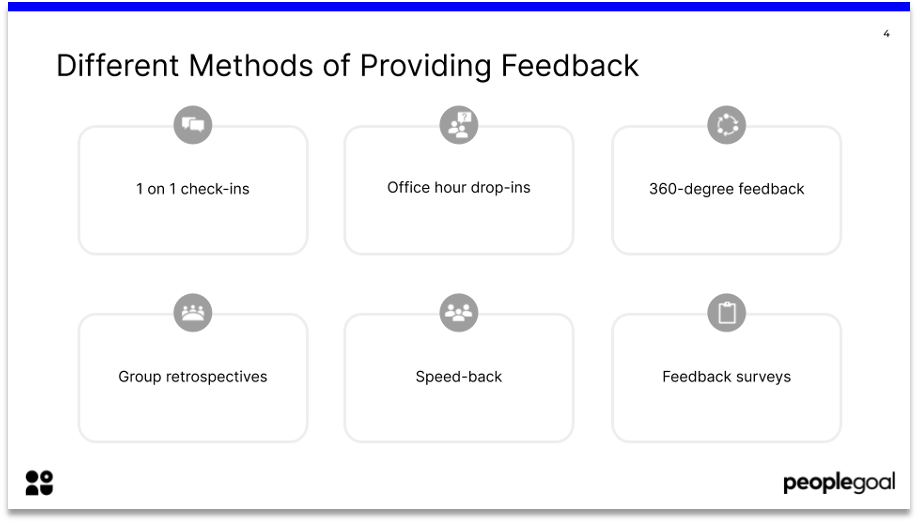
How to establish a feedback culture
1. Feedback should work both top down and bottom up
It is important the employees also get the opportunity to feedback their thoughts and opinions to the organization within the feedback loop.
2. Provide feedback training to managers and employees
Provide feedback training so that employees and managers understand the positive impact of feedback, rather than viewing it as a chance to express critical comments. They need to understand that feedback is a vital learning and development activity.
3. Give good feedback
Ask for permission, share observations, explain impact, wait and listen and suggest a solution.
4. Schedule regular feedback meetings
Feedback must be timely and continuous.
5. Feedback conversations should be collaborative
Train your people to conduct collaborative feedback conversations. It should be a dialogue between the feedback giver and the recipient. When you are giving feedback, it is also important to listen to the other person's perspective.
6. Feedback should be future-focused
When we think about the past, people tend to blame problems on factors beyond their control (e.g. resources, or luck), whereas when we look toward the future we focus on attributes that we have the power to control (like decision-making, personal responsibility or effort). Having future-focused feedback conversations will encourage employees to take more responsibility to initiate decisions that will help them to achieve their goals.
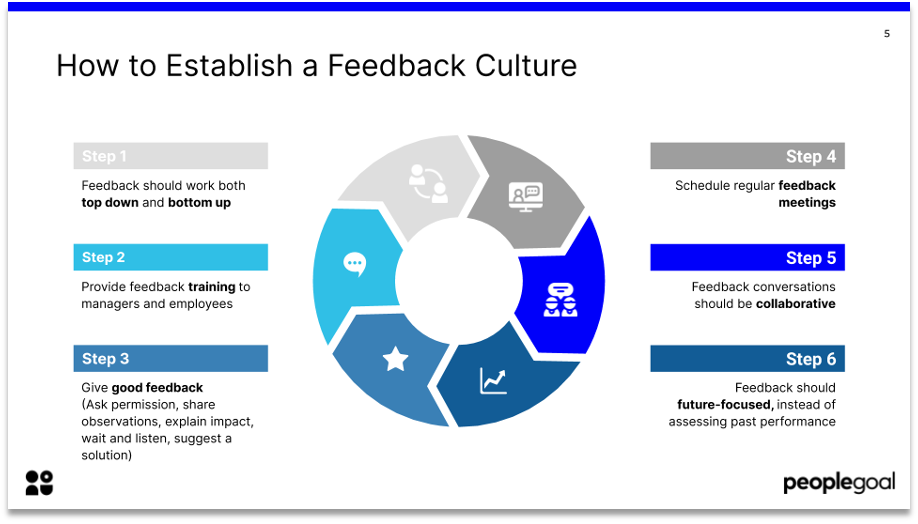
Challenges when giving and receiving feedback remotely
- Lack of face to face communication
- Employees have been impacted by the pandemic, so managers want to avoid giving negative feedback
- Mix of remote and office workers complicates performance feedback process
- Feedback meetings are the first meetings to be cut when organization's are busy
Whilst working remotely can complicate the feedback process, there are various actions you can take to reduce its impact. Firstly, when giving feedback remotely, ensure that you turn your video on. This will facilitate communication by allowing you to read the other persons facial expressions.
Despite the difficult situation, it is still really important to give feedback to employees. Withholding feedback to protect their feelings will do more harm than good in the long term. Instead, take an objective view and focus on giving them constructive feedback that assesses specific facts. Giving feedback gives the person the opportunity to learn and work on areas that need development.
As remote working becomes the 'new normal' establishing a feedback culture is more important than ever. Remote working is here to stay, so it cannot continue to be something that holds us back. Action needs to be taken now to establish a feedback mechanism that is compatible with both the home and office environment.
Due to the transition to remote working, many organization's have put their feedback process on the back-burner, and are focusing instead on other areas of the business like setting new goals and future planning. However, as we approach the end of the year feedback is more important than ever, and if organizations want to survive and thrive beyond the pandemic it is essential that they implement a culture of feedback.
Three approaches to feedback
Qualitative
Qualitative feedback consists of open-ended questions or narrative style assessments. This works particularly well with organizations that run frequent feedback processes.
Quantitative
Quantitative feedback is based on statistics. It consists of numerical rating scales and percentage completion towards goals. This method works well with sales driven organizations, and for less regular feedback cycles like quarterly evaluations.
Hybrid model
The hybrid model consists of a combination of qualitative and quantitative feedback. It is a great method to measure both essential soft skills and set a clear direction, creating alignment between the manager and employee in terms of expectations and work outcomes.
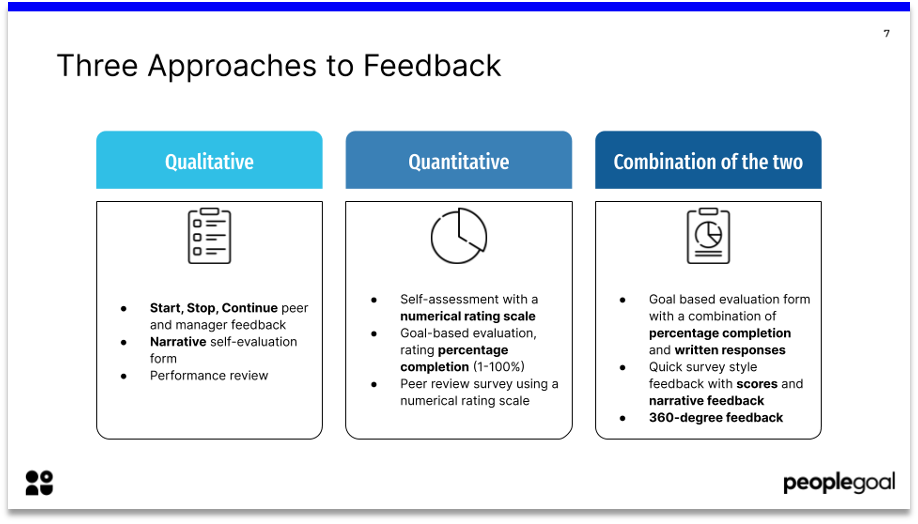
Key Takeaways
- A strong organizational culture is built on a strong feedback culture
- Practice continuous feedback
- Feedback conversations should be collaborative and focus on improvement
- Focus on future performance rather than assessing past performance
- Use a combination of qualitative and quantitive feedback approaches
Want to learn more?
Enjoyed learning about remote performance reviews? Check out the full webcast here.
Catch up with our two previous webcasts on performance reviews and goal setting below:
Need some help kicking off your continuous feedback process? Book a demo with PeopleGoal here.
